NRC's Inspector General Understands His Role,
Why Doesn't FCC's IG Understand His?
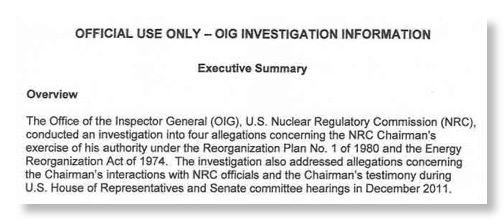
The role of the FCC’s Inspector General has been a recurring topic here. Especially the historic unwillingness of the FCC’s IG to look into the functioning of the Commission and instead to focus nearly all resources on the fraud issues that are also a legitimate part of the IG role. An earlier pair of posts here was entitled “A Credible Inspector General Would Make FCC More Credible”.
It was pointed out that ALL federal agency IG’s have the same legislative charter.
They are ALL obligated by 5 USC App. 4(a)(2)
to review existing and proposed legislation and regulations relating to programs and operations of such establishment and to make recommendations in the semiannual reports required by section 5 (a) concerning the impact of such legislation or regulations on the economy and efficiency in the administration of programs and operations administered or financed by such establishment...
The only difference between cabinet level IGs and independent agency IG’s is who appoints them and whether they are subject to Senate confirmation. Their roles and obligations are identical under the above statutes.
The above report was obtained by and published by The Hill and summarizes a recent NRC IG report about possible transgressions by its chairman. Those of us who remember Chairman Kevin Martin may recognize some parallel issues. Of course, Chmn. Martin never had to worry of the FCC IG would ask questions like when he “attempted to control the content and flow of information to the Commission” (“Issue 3 Allegation” , p. v) or whether the “Chairman’s interpersonal interactions with (the Commission) staff and Commissioners has created a chilled workplace environment” (“Issue 5 Allegation”, p. vii) Perhaps if Kevin Martin had had a truly independent IG he might have moderated his behavior - either in response to such oversight or might have avoided some of his bizarre actions if he knew such oversight was possible - and the FCC might have been more productive during his tenure
Until the appointment of the present IG, all FCC IGs had been long term FCC staffers who were known not to “shake the boat”. Indeed, the previous IG, while he was working in OET, told an acquaintance of mine who worked for him that he should not be concerned about a clear violation of ex parte rules because that was just accepted practice at FCC!
FCC as an institution never learns from previous problems. Isn’t the current problem at TV channel 51 with adjacent mobile bands a close cousin of the Channel 14 and 69 problems of the 1980s? Didn’t FCC staff cover up the existence of police radar detector interference to VSATs for a decade before acting? Why don’t emerging interference problems become visible on policy makers’ desks? What can be learned from the GPS/LightSquared issue? Indeed, an FCC IG review of GPS/LS might have made the Commission’s actions seem more reasonable and responsible. As I said earlier, “A Credible Inspector General Would Make FCC More Credible”.
UPDATE
The whole NRC IG report has still not been made public, although Chairman Jaczko has issued a public statement disputing it. However, some publications apparently have the whole text now. Here as some juicy tidbits that Platts.com published:
The IG's report follows complaints by NRC's four other commissioners late last year that Jaczko was prone to angry outbursts and withheld information from his colleagues.
The report described two tense interactions between Jaczko and (NRC Commissioner Kristine) Svinicki that left her "shaken" and describes another incident after which Svinicki was apparently unwilling to be alone in her office after business hours.
The report said that in March 2011, an unnamed witness said Jaczko stormed to Svinicki's office after hours, upset about a letter Svinicki and other commissioners had sent to a member of Congress. Finding her office locked, Jaczko "was ranting, cursing and had banged on Commissioner Svinicki's suite door," the staff witness told Svinicki later, according to the IG report.
Svinicki was inside her office but did not hear Jaczko, the report said.
After learning of the event, Svinicki changed her behavior, leaving the office as soon as her staff departed for the day and being escorted to her car for a period of time, the report said.
And
The report included 15 examples where Jaczko's behavior, according to the IG report, "was not supportive of an open and collaborative work environment" and left some subordinates feeling "bullied."
Commissioner William Ostendorff told the IG that in a "very heated" meeting about post-Fukushima agency actions, Jaczko "lost his temper," then threw his gavel on the table and closed the meeting while Ostendorff was still speaking.
The IG said it had received a statement in March from Jaczko's attorneys saying the chairman had taken "numerous steps" since the December hearings to improve his relationship with commissioners and staff.
The report concluded that Jaczko's testimony to Congress during the December hearings was different from what staff told the IG in five areas but said the Department of Justice concluded "the matter did not warrant prosecution."
Doesn’t this remind you of Chmn. Martin?
IIT's Spectrum Observatory: Some Questions Its Data Could Answer
While traveling this week I visited the Illinois Institute of Technology in Chicago and met with Dennis Roberson, an old acquaintance who had invited me to give a seminar. Dennis showed me around the beautiful Mies van der Rohe-designed campus and kindly arranged that the seminar be given in S. R. Crown Hall , a National Historic Landmark designed by van der Rohe.
I was particularly fascinated by the NSF-supported Spectrum Observatory that Dennis has described as follows:
Spectrum is a scarce natural resource that we depend on to an ever increasing degree for our social interactions, our protection and emergency services at the national and global level and the efficient conduct of business both here and around the world. This resource is extremely valuable commanding prices in the U.S. in the range of $250,000,000 per MHz for prime spectrum property. Even the President has become directly involved in an effort to move 500 MHz of spectrum to commercial broadband providers (usually cell phone service providers) in an attempt to spur economic growth, create jobs and to help to resolve the Federal Budget deficit. Given its value and importance, surprisingly little is really known about the current usage and the trends in the spectrum occupancy in the various geographies in the U.S. and around the world. To help resolve this issue, Illinois Institute of Technology through its Wireless Network & Communications Research Center (WiNCom) developed a Spectrum Observatory to monitor the spectrum occupancy in the "Loop," the business center of the City of Chicago.
As shown at left, the Spectrum Observatory covers 30-6000 MHz. It has been operating since July 2007 from a 22 story site at the IIT campus a few km south of the downtown Chicago. The basic arrangement and some of the data collected are reviewed in a DySPAN 2011 paper.
225-400 MHz Band Data. Some data in the DySPAN paper shows occupancy in the 225-406 MHz band. A previous post here reviewed NTIA’s disinterest in reviewing occupancy of this band although it has reviewed occupancy of nearby federal bands. 225-400 MHz is mostly a military aeronautical mobile band. There are some other things in it including mobile satellite links that go back to the Cold War.
There is a military base in downtown San Diego that uses this band, but not in other urban areas where there are a real spectrum shortages. Shared use of 225-400 MHz, perhaps on an interruptible spectrum basis, could help add spectrum to meet real US needs. NTIA’s reluctance to explore this by collecting data shows the basic problem of US spectrum policy in the current arrangements and the need for the recent PCAST federal spectrum recommendations. But to explore the feasibility of shared use we need real data on its present use and the IIT data is a great step in the right direction. Preliminary analysis in the DySPAN paper shows that for the period 2008 - 2010 the occupancy of 225-406 MHz had a maximum less than 20%. This initial analysis could be a good starting point for more detailed analysis by FCC and NTIA of this NSF-funded data collection.
Estimating Radio Noise Trends. Another interesting question that might be addressed from this unique data source is long range trends in spectrum noise. There is anecdotal evidence that it is increasing, but no real data. TV channel 37, 608-614 MHz, is a primary radio astronomy allocation and is basically unused - although this is some minimal licensed use for critical care medical telemetry in hospitals. A long term examination of this or other channels that should not be used in Chicago could reveal hard data on whether background noise is urban areas is changing.
===
The IIT Radio Observatory is a unique resource and kudos to IIT for proposing and operating it and to NSF for funding it. Unfortunately it is not that well known despite several published papers. Hopefully better understanding of this resource can lead to more informed spectrum policy decisions. But then again I once had a boss at FCC who was head of OET who said “Never ask a question unless you are prepared to hear the answer.”
UPDATE
See http://www.marcus-spectrum.com/Blog/files/SpecMeasCorr414.html
Sen. Grassley: Your Recent "Marimba Moment" Was Not All Your Fault - Your friends in the Cellular Industry Made It Inevitable
In January, this blog had a post entitled “Is the Cellular Industry ‘Tone Deaf’ ”? It described a 1/12/12 New York Philharmonic concert of Mahler’s 9th Symphony that was interrupted by an iPhone Marimba ringtone from a front row seat.
At the time I wrote:
The cell phone industry is united against legalizing jamming, but seems unable to do anything about antisocial cell phone usage that inevitably leads to interest by concert halls and restaurants in cellular jamming. As previously stated here, French national law explicitly permits cellular jamming in concert halls. While jamming in such urban locations inevitably will cause other problems and is thus a bad idea (as opposed to jamming in isolated maximum security prisons where the geometry is very different), there seems to have been little interest in the cellular industry in alternative approaches to minimize the antisocial aspects of cell phone use.
The cell phone industry is usually a positive contributor to US society and the US economy. But it continues to have some blind spots as outlined in the previous New Year's Resolutions post here. Maybe it should address them? Maybe FCC leadership should politely point out these issues from time to time and mention the possible impact of neglect?
In my New Year’s Resolutions for the Cellular Industry post I wrote
That post’s 7 issues attracted NO inquiries from the cellular industry which apparently is focusing all its efforts on its appetite for spectrum, not social harmony resulting from its products and services. (In fairness one high CTIA official did reply to an e-mail from me about the post and seemed puzzled why people had trouble turning off their ringers.)2. Social harmony and cell phone use. Does the cellular industry ever wonder why the public rose up in force against the Docket 04-435 proposals to allow cellphones in airplanes or why there is a market for (presently) illegal cell phone jammers? The reason is that there is a lot of obnoxious cellphone use in this country! Airplanes are one of the few places without it and the public outcry was to preserve that. There is an interesting essay by Don Norman that was prepared for a 2005 Motorola Research Visionary Board meeting entitled “Minimizing the annoyance of the mobile phone: The Annoyance, Irritation, and Frustration of The Mobile Phone -- A Design Challenge” that starts off with the quote “Nearly one in three (30%) adults say the cell phone is the invention they most hate but cannot live without”.
What is the industry doing about this? Are they trying to increase sidetone levels so people don’t shout when using cell phones? Are they trying to make it easier to switch the ringer to a vibrate only/ “manners mode” as in Japan where all carriers have voluntarily agreed that a press of the “#” key toggles the unit to and from vibrate only mode? Are they researching ways for theaters and restaurants where people really want a semblance of quiet to use Bluetooth or a similar link to switch phones automatically to vibrate only? Kudos to Motorola for inviting Dr. Norman to talk on this issue. How much of this type of dialogue is going on now in the industry?
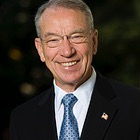
Senator Grassley, don’t feel bad about the incident. These types of things happen all the time because there is no consistent simple way to turn off the ring tone of US cell phones as there is in Japan. The cellular industry is much too busy grabbing spectrum to care about such issues of “unintended consequences”. It feels it can use its position of political strength to stop the sale of cellular jammers which people use illegally in selfdefense of obnoxious cell phone use.
In order to keep this “clear bright line” on jamming in effect, the industry even fights the use of cell phone jammers in isolated prisons where they could be a cost-effective option to enhance public safety. But apparently the cellular industry has never learned from the War on Drugs: to defeat a serious contraband issue you must address BOTH supply and demand. FCC may go through the appearances of being active against the selling of cell phone jammers, but the small and dispirited Enforcement Bureau technical staff doesn’t stand a chance against Chinese Internet marketing unless the demand is moderated also.
Sen. Grassley, at least you handled your moment much better than Sen. McCain handled his a few years ago on the Senate floor:
WashPost "FCC considers whether to study cellphone radiation"

A”phantom” often used for SAR measurements.
Simulated cavity is filled with special liquid to simulate body’s electromagnetic qualities.
Probe is inserted in simulated head to measure electromagnetic fired resulting from cell phone emissions and focusing or diffusion by body shape and its physical parameters such as conductivity.
Cell phone tested is under body cavity and can’t be seen in this photo.
(FCC also permits computer calculations of SAR that consider body shape and parameters.)
Last night the Washington Post posted an article on its web site that appeared in today’s print edition with the above title. The Post’s Cecilia Kang wrote:
The Federal Communications Commission is seeking to study whether it needs better guidelines to protect people from cellphone radiation, a question it hasn’t posed in 15 years…
The debate is sure to draw heavy interest. The deep-pocketed wireless industry opposes changes to current federal rules. Health advocates have argued that the government has ignored safety concerns raised by some scientists.
Studies have been split on the matter. Some have indicated that cellphone use poses no risk to humans.
Ms. Kang points out correctly that the 5 commissioners must vote to start any reexamination, something a little in doubt due to the cellular industry’s likely opposition and the degree that the current commissioners have focused on meeting the cellular industry’s spectrum demands - virtually ignoring former “top dog”- the broadcasting industry - in the process.
Historically, though, FCC has never really picked an RF safety standard. Since FCC is not a health and safety agency it has always deferred to a troika of such agencies (Environmental Protection Agency, Occupational Safety and Health Administration, and National Institute of Occupational Safety and Health) to recommend specific protection standards for the public and for occupational workers. FCC has consistently used standards that were proposed by the 3 agencies at the end of its rulemaking process. (Amusingly,a decade or 2 ago the Defense Department was embarrassed over the difference between its standard for exposure of GIs and the FCC occupational standard and sought a place at the table as a 4th “health and safety agency” so it could moderate FCC’s positions even though they did not legally apply to the exposure of GIs. FCC wisely rejected giving DoD an inside role with off the record participation as a “health and safety agency”.)
Readers are reminded of an earlier post on the “OETB65C problem” that the cellular industry no doubt would prefer remain “under the carpet”. While the Commission’s rules specify human exposure limits and set as SAR limit of 1.6 W/kg for the head, 47 CFR 2.1093, some of the key details for measuring the SAR and interpreting the rule is given in the more obscure OET Bulletin 65, Supplement C, “Evaluating Compliance with FCC Guidelines for Human Exposure to Radiofrequency Electromagnetic Fields:
Additional Information for Evaluating Compliance of Mobile and Portable Devices with FCC Limits for Human Exposure to Radiofrequency Emissions”, last revised in January 2001 - a time during the Bush 43 transition when it got little attention either within FCC or in the public and no notice and comment.
On p. 41-2 of OETB65C it states,
.Body-worn operating configurations should be tested with the belt-clips and holsters attached to the device and positioned against a flat phantom in normal use configurations. ... Both the physical spacing to the body of the user as dictated by the accessory and the materials used in an accessory affect the SAR produced by the transmitting device. ...Body-worn accessories may not always be supplied or available as options for some devices that are intended to be authorized for body-worn use. A separation distance of 1.5 cm between the back of the device and a flat phantom is recommended for testing body-worn SAR compliance under such circumstances. Other separation distances may be used, but they should not exceed 2.5 cm
Thus the manufacturer can use body separation of up to 2.5 cm (about 1 inch) to show compliance without either providing a portable device holder or even telling the buyer that it must be kept an inch away from the body, i.e. do not put it in your pocket! A truly great loop hole!
So in an open rulemaking FCC adopted the SAR standard of 1.6 W/kg and in a mysterious OETB65C drafting process the OET staff gutted some key provisions! Now the cellular industry’s lawyers think it can decrease its liability if any adverse health effect is ever found by saying that its products meet all FCC rules. Isn’t liability decrease for key FCC regulatees a key FCC function? Or was it supposed to be the public interest? I keep forgetting.
In any case, hopefully FCC will allow a public review of RF safety standards for the first time since 1996 and will avoid the transparency problems associated with the drafting of the current OETB65C by seeking either including key provisions in the rulemaking or asking for public comment on a draft.
NAB Uses Twitter to Redact History on the FM Radio in Cell Phone Mandate Issue
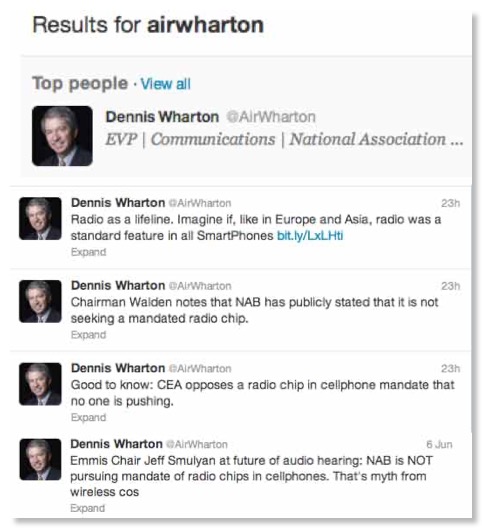
While researching the previous post here on NAB’s new interest in cognitive radio, your blogger discovered the above tweets from NAB Executive Vice President of Communications Dennis Wharton on his airwharton Twitter channel. Readers may recall that a widely reported NAB push on Congress for legislation mandating FM receivers in ALL cell phone was a recurring topic here in August - October 2010. We thought NAB had just given up on the issue. No!
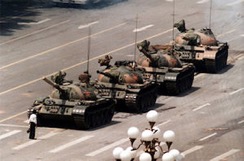
Was the reported push for legislation really a “myth from wireless cos”? First we have below a 2010 news item from the CBS website. Since CBS is an NAB member we assume that they are not a tool of the cellular industry. Note especially the comment at 1:05 - 1:55 of the video.
While I can’t find a public quote from Mr. Wharton supporting the legislation that would have required FM receivers in cell phones, he seemed awfully upset in August 2010 about a cellular industry letter to the Chairmen and Ranking Members of the House and Senate Judiciary Committees opposing the then pending legislation, saying “it would be unfortunate if telco gatekeepers blocked access to public safety information offered by free and local radio."
In an August 6, 2010 NAB release that “can be attributed to NAB spokesman Dennis Wharton”, it states:
At the direction of House and Senate leaders in late 2009, NAB met with MusicFirst - representing artists, labels and unions. To date discussions have yielded the following potential terms. These terms have NOT BEEN AGREED TO, but are under discussion by the industry.
They include:
-Tiered rate of 1% or less for all net revenue (roughly $100 million for the industry) which is permanent and can not be adjusted without changing statute or by mutual agreement
-PERMANENT removal of CRB jurisdiction for terrestrial and streaming
-Streaming rate reduction from current rates
-Inclusion of radio chips on all mobile phones
-AFTRA issues resolved (agency commercial replacement on webcasts)
Note the next to the last item, “Inclusion of radio chips on all mobile phones”. Thus NAB stated in 2010 that it was discussing an FM radio mandate as part of a package of items with the music industry group MusicFirst to settle a music copyright dispute between them. So while in some strict sense NAB never formally agreed to the specific package of terms that included the FM mandate, the phrase in Mr. Wharton’s June 6 tweet about a “cellphone mandate that no one is pushing” seems less than candid.
It is clear that NAB was pushing this mandate in August 2010, it just never agreed on final package with the music industry. At the time NAB publicly disagreed with the cellular industry on the need for a mandate - they never denied their support for it until this current series of tweets.
NAB was perfectly happy to put this mandate on the cellular industry and consumers who have voted “with their feet” not to buy the few models of cell phones that include FM receivers. Perhaps if the broadcasters put some compelling content on their stations they might get listeners without mandates. NAB also has pressed FCC for HD Radio mandates to help prop up that technology that consumers are rejecting.
NAB, I’m sure you are good Republicans who object to the “Obamacare” insurance mandate. Why are you pushing all these other mandates and then denying it?
(For the record, your blogger is an avid NPR listener and a paid member of WAMU-FM.)
UPDATE
CTIA has now jumped in with this YouTube video dumping on NAB on this issue. (Note that CTIA says on 2 out of 20 people interviewed said they used their cell/smart phone to listen to FM. However, their is no indication of how many had that option since few cell phones at present have the capability. It really was an unfair question, although I think a fairer question would have got the same answer.)
I would love to moderate a public discussion between Mr. Wharton and Mr. Walls on this issue!
CTIA has now created a Twitter hashtag #nofmchipmandate . So if you need constant updating on how silly two powerful trade associations with million dollar CEOs can behave, just enter this into your favorite hashtags list and watch the silliness in real time!
NAB: Cognitive Radio is Effective Enough to Allow Sharing of Critical Government Frequencies - But Not Good Enough to Protect Broadcast TV
So you can see how surprised and excited I was to get the e-mail shown at left from Dennis Wharton, Executive Vice President of Communications at NAB, with the subject line “The spectrum crisis is completely avoidable”. We certainly want to avoid this crisis and I was delighted to read what NAB’s new solution was. The message begins with “I thought you might find of interest this article from The New York Times about technological solutions to increase the efficiency of wireless mobile broadband networks.” The Times article was mainly about the PCAST spectrum report that SpectrumTalk readers read about here on May 28th. In the article Mr. Wharton was kind enough to recommend was a discussion of how effective cognitive radio technology now is and the statement “For example, if the government has reserved some spectrum for use at an Air Force bombing range, but no bombing is happening on a particular day, cognitive radio could allow a phone to sense the open channel and switch to it.”
Mr. Wharton, let me explain why it is much easier for a cognitive radio to sense in TV white space whether there are usable TV signals than the case of sensing the presence of military signals:
- TV signals are generally on 24/7, they do not turn on and off at random times as military signals do.
- TV transmitters are firmly bolted to the ground in well defined locations.
- TV signals have a very precisely defined (in a public documentation) 6 MHz wide waveform with very precise frequency stability and timing. It is almost as if they were designed to be detected at much greater sensitivity than a consumer receiver. Indeed, FCC testing showed that they could be detected at a power level 35 dB less than the sensitivity of a TV receiver and better detectors are possible. In general military signals do not have waveforms that are known to the public. Thus the U-NII cognitive radio rules in 47 CFR 15.407(h)(2) require a “Radar Detection Function of Dynamic Frequency Selection” that knows nothing about the radar signal it is trying to detect since the military would no divulge the specific technical details of the radars in the band - a far cry from the well known ATSC signal in the TV band!
- If interference is caused to TV reception, it may be unfortunate but there are no permanent negative consequences - like death or injury. If there is interference to a military system the consequences could me more severe.
Based on the above, cognitive radios in the TV band raise far fewer issues than cognitive radios that try to detect the presence of military signals.
Since Mr. Wharton has concluded that cognitive radio technology has now advanced to the point that it can reliably detect the presence of military signals to allow broadband use of military bands when and where they are not in use, I assume that NAB must now endorse the technically simpler case of using of cognitive radios in the TV bands under similar terms.
I hope Mr. Wharton comes to the DySPAN 2012 Conference in Bellevue WA in October and explains NAB’s new view on cognitive radio. I’m sure he’ll get a standing ovation!
Proceedings of the IEEE Paper on Radio Spectrum Access Published

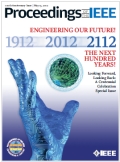
“A special 13 May centennial issue, published as the thirteenth issue of 2012, reviews 19 key technologies from three perspectives: the past, the present, and prospects for developments in the future. ”
The article is available for free to subscribers to IEEE Xplore. Here is the abstract:
Here also are the conclusions of the article:Classic spectrum management policies and regulations focused on unique frequency assignments for users to avoid intersystem interference. The growing demand for wireless communications along with the recognition that classic spectrum management leads to underutilized spectrum in time and spacehas resulted in interest in radio spectrum access techniques. Since spectrum use is highly regulated at the national and international levels, the status of regulatory policies is key to the implementation of new access technologies.
The major obstacle to RSA use has been incumbent users who fear interference and in some cases newcompetition. At times, RSA advocates have not been sensitive enough to these concerns and pragmatic in dealing with them. Incumbent spectrum users both have a significant stake in spectrum use as well as major influence in national and international policy fora. Spectrum policies that reward incumbents for supporting more intense use ofspectrum may be one method of making the interests of incumbents better aligned with goals of more intense spectrum use. While passive monitoring systems for determining spectrum availability are possible in some applications, active engagement of incumbents in realtime determination of spectrum availability will result in cooperative systems that both decrease incumbents’ legitimate concerns as well as maximize the amount of spectrum available for RSA for a given interference risk probability.
It is difficult to build cooperative systems as modifications to incumbent systems designed for exclusive spectrum use. Thus, standards and regulatory policies that encourage spectrum users to make data available on instantaneous spectrum use and expected changes in use would facilitate cooperative RSA systems and also help protect incumbent use.
If incumbent opposition can be moderated through cooperative RSA systems or if national and international regulators take a bolder approach in maximizing public interest in spectrum by insisting on spectrum access techniques that use the resource more intensively, then RSA will serve a key role in facilitating more intense spectrum use and its economic and societal benefits.
The 700 MHz LTE Public Safety Plan: Some Concerns
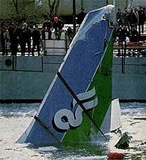
For all its flaws, the European nations now have TETRA as their public safety network core. But the previous Motorola so thoroughly orchestrated the dissing of TETRA in favor of their preferred P25 in order to maintain market hegemony , that the US ended up with neither system. (At one point Motorola - not really the same company that exists today with that name - even tried to use its ownership on a patent used in TETRA to prevent any use of TETRA in USA. The ongoing Docket 11-69 deals with the issue of any future use of this technology in the US, not just public safety.)
Two issues dealing with 700 MHz LTE for public safety don’t get much discussion, so I will review them here:
1) 700 MHz This band is comparable to one of the frequencies used for cellular telephony since the 1980s. Many of us think of cellular service as ubiquitous, but it really isn’t in terms of the land mass of the US. The map at right is the coverage area of VerizonWireless and there are certainly coverage gaps in rural areas, specially those with rugged terrain. 700 MHz has slightly better propagation than the 800 MHz cellular band, but that will not solve this problem. It is not clear if it is economically practical to cover the US with 700 MHz coverage even if the cellular industry shared infrastructure with the new public safety network. Public safety officers lives depend on ubiquitous communications. Statewide public safety agencies, as well has local and regional agencies in rugged terrain, often use the 30-50 MHz band what has much greater range than higher bands although suffers from reliability problems due to quirky propagation phenomenon and also attracts little 8th Floor interest. A ULS search reveals 15,849 current (nonfederal) public safety licenses in this long range band. (Note that Spectrum Dashboard does not cover this low policy interest band - so we can’t give you any maps.)

Now the nationwide public safety system could supplement the 700 MHz LTE systems with a more limited capability satellite (MSS) systems that provides connectivity where 700 MHz isn’t available. For example, the recently announced DeLorme inReach device uses the Iridium network and shows that limited emergency capability in isolated areas is available now at modest cost. But I have not seen any discussion about supplementing 700 MHz coverage with alternative media, such as MSS, for public safety agencies that will never have ubiquitous 700 MHz coverage in their territory. So how will the 15,849 present 30-50 MHz public safety licensees transition to the new 700 MHz system?
2) Voice over LTE Voice is an integral part of public safety communications now and in the foreseeable future. While using voice on an LTE system appears technical possible, it is not an operational reality. Last month, NetworkWorld quoted Verizon Vice President of Network Hans Leutenegger as saying that VZW “won't be deploying any voice over LTE (VoLTE) services on its network until late next year at the very earliest.” Public safety networks need not only voice, but voice with special features such as priorities, preemption, and network control by the commanders of first responders. These features are not operational as yet and it is not clear if the resources programmed for their development and testing are really adequate for the task - given the high reliability we owe our public safety officers.
More than a decade ago, the public safety community was greatly indebted to the old Motorola who invented this technology and shepherded it introduction into the public safety. Groups like APCO in the past showed their appreciation by allowing Motorola to manipulate their spectrum policy positions before FCC and they consistently opposed technical evolutions much more modest than which is involved here. Indeed, the fact that we are only now finishing the 20 year narrowband transition shows the effectiveness of this Motorola “partnership” with public safety that slowed technical progress while maintaining Motorola’s market share. The present Motorola Solutions no longer has the control of the old Motorola and others entities are trying to manipulate the public safety community for their own gains.
The fact that the public safety community generally seems happy with the present plan may indicate that the new manipulators have successfully filled the power vacuum left when Motorola was restructured. Hopefully the public safety community will become more cynical about being manipulated in the corporate interests of others and they will aggressively make sure their own interests are pursued in the development of the national wide interoperable system that is so critically needed.
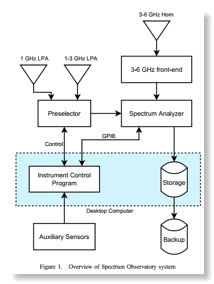

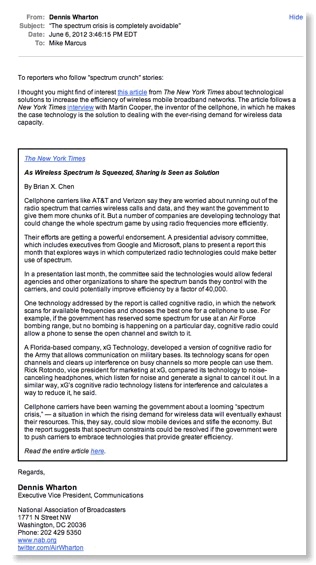


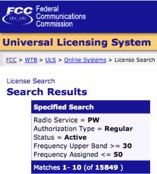


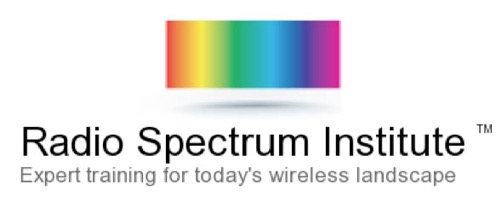


![Validate my RSS feed [Valid RSS]](valid-rss-rogers.png)

